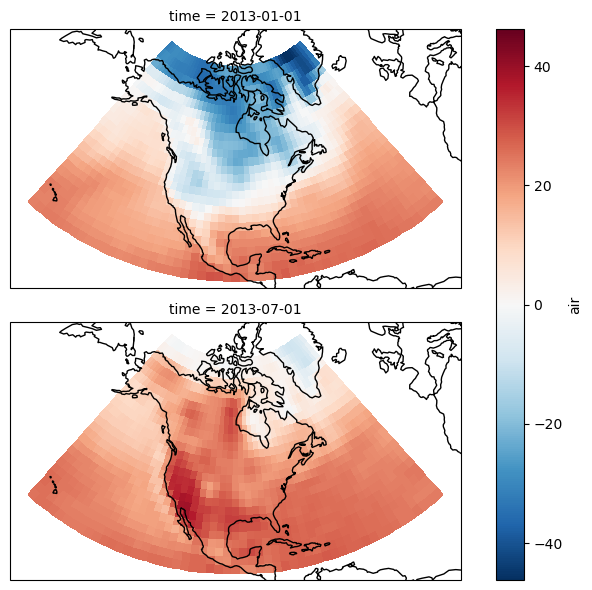You can run this notebook in a live session or view it on Github.
Visualization Gallery#
This notebook shows common visualization issues encountered in xarray.
[1]:
import cartopy.crs as ccrs
import matplotlib.pyplot as plt
import xarray as xr
%matplotlib inline
Load example dataset:
[2]:
ds = xr.tutorial.load_dataset("air_temperature")
Multiple plots and map projections#
Control the map projection parameters on multiple axes
This example illustrates how to plot multiple maps and control their extent and aspect ratio.
For more details see this discussion on github.
[3]:
air = ds.air.isel(time=[0, 724]) - 273.15
# This is the map projection we want to plot *onto*
map_proj = ccrs.LambertConformal(central_longitude=-95, central_latitude=45)
p = air.plot(
transform=ccrs.PlateCarree(), # the data's projection
col="time",
col_wrap=1, # multiplot settings
aspect=ds.dims["lon"] / ds.dims["lat"], # for a sensible figsize
subplot_kws={"projection": map_proj},
) # the plot's projection
# We have to set the map's options on all axes
for ax in p.axes.flat:
ax.coastlines()
ax.set_extent([-160, -30, 5, 75])
/tmp/ipykernel_3888/4058645139.py:10: FutureWarning: The return type of `Dataset.dims` will be changed to return a set of dimension names in future, in order to be more consistent with `DataArray.dims`. To access a mapping from dimension names to lengths, please use `Dataset.sizes`.
aspect=ds.dims["lon"] / ds.dims["lat"], # for a sensible figsize
/tmp/ipykernel_3888/4058645139.py:15: DeprecationWarning: self.axes is deprecated since 2022.11 in order to align with matplotlibs plt.subplots, use self.axs instead.
for ax in p.axes.flat:

Centered colormaps#
Xarray’s automatic colormaps choice
[4]:
air = ds.air.isel(time=0)
f, ((ax1, ax2), (ax3, ax4)) = plt.subplots(2, 2, figsize=(8, 6))
# The first plot (in kelvins) chooses "viridis" and uses the data's min/max
air.plot(ax=ax1, cbar_kwargs={"label": "K"})
ax1.set_title("Kelvins: default")
ax2.set_xlabel("")
# The second plot (in celsius) now chooses "BuRd" and centers min/max around 0
airc = air - 273.15
airc.plot(ax=ax2, cbar_kwargs={"label": "°C"})
ax2.set_title("Celsius: default")
ax2.set_xlabel("")
ax2.set_ylabel("")
# The center doesn't have to be 0
air.plot(ax=ax3, center=273.15, cbar_kwargs={"label": "K"})
ax3.set_title("Kelvins: center=273.15")
# Or it can be ignored
airc.plot(ax=ax4, center=False, cbar_kwargs={"label": "°C"})
ax4.set_title("Celsius: center=False")
ax4.set_ylabel("")
# Make it nice
plt.tight_layout()

Control the plot’s colorbar#
Use cbar_kwargs keyword to specify the number of ticks. The spacing kwarg can be used to draw proportional ticks.
[5]:
air2d = ds.air.isel(time=500)
# Prepare the figure
f, (ax1, ax2, ax3) = plt.subplots(1, 3, figsize=(14, 4))
# Irregular levels to illustrate the use of a proportional colorbar
levels = [245, 250, 255, 260, 265, 270, 275, 280, 285, 290, 310, 340]
# Plot data
air2d.plot(ax=ax1, levels=levels)
air2d.plot(ax=ax2, levels=levels, cbar_kwargs={"ticks": levels})
air2d.plot(
ax=ax3, levels=levels, cbar_kwargs={"ticks": levels, "spacing": "proportional"}
)
# Show plots
plt.tight_layout()

Multiple lines from a 2d DataArray#
Use xarray.plot.line on a 2d DataArray to plot selections as multiple lines.
See plotting.multiplelines for more details.
[6]:
air = ds.air - 273.15 # to celsius
# Prepare the figure
f, (ax1, ax2) = plt.subplots(1, 2, figsize=(8, 4), sharey=True)
# Selected latitude indices
isel_lats = [10, 15, 20]
# Temperature vs longitude plot - illustrates the "hue" kwarg
air.isel(time=0, lat=isel_lats).plot.line(ax=ax1, hue="lat")
ax1.set_ylabel("°C")
# Temperature vs time plot - illustrates the "x" and "add_legend" kwargs
air.isel(lon=30, lat=isel_lats).plot.line(ax=ax2, x="time", add_legend=False)
ax2.set_ylabel("")
# Show
plt.tight_layout()
